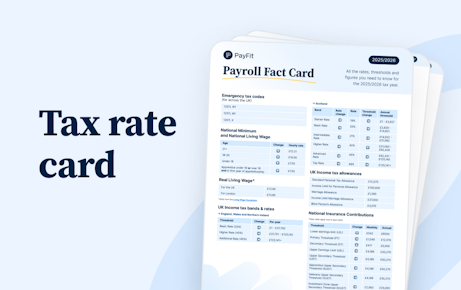A Guide to the Minimum & Living Wage for UK Employers in 2025/2026


Ahead of the new UK tax year, understanding the intricacies of the National Minimum Wage (NMW) and National Living Wage (NLW) is crucial for UK employers. This guide aims to demystify the two concepts, offering clear insights into both the UK National Minimum Wage for 2025/2026, plus the National Living Wage, and how they impact both employers and employees. We’ll explore what businesses should be doing to prepare for the changes, as well as cover the differences between the National Minimum Wage and National Living Wage.
So, without further ado…
What is the National Minimum Wage in the UK?
The UK National Minimum Wage is a minimum pay per hour almost all workers under the age of 21 (formerly 23) are entitled to by law. The amount varies depending on the worker's age and whether they are an apprentice (more on this later). Introduced in 1998 by the then Labour government, its primary aim is to protect workers from unduly low pay, ensuring a minimum standard of living for UK workers.
And what is the National Living Wage?
Introduced in April 2016, the National Living Wage is higher than the National Minimum Wage and applies to workers aged 21 and over. Understanding the difference between the NMW and NLW is crucial. To recap, National Minimum Wage was the minimum pay applicable by law for under 23s and apprentices (but is now for under 21s); National Living Wage refers to the mandatory minimum amount that must be paid to everybody else. Both seek to ensure that UK workers of different ages are fairly compensated for their labour.
The National Living Wage for 2024 was set at £11.44 per hour, however from 6th April 2025 this is increasing, as per the Autumn Budget, to £12.21.
The UK National Minimum Wage in 2025/26
For 2025/26, the UK government has announced updates to the NMW and NLW rates, reflecting the ongoing commitment to support workers’ financial wellbeing. It's essential for employers to stay informed of these changes to ensure compliance and fair treatment of their employees (PayFit automatically updates all rates in its platform as they happen, which are then reflected in future pay runs for employees, ensuring compliance - more on this later).
| Rate/Age | Mimimum mandatory amount for 2025/26 (increase on 24/25) |
|---|---|
| National Living Wage / 21+ | £12.21 (+£0.77) |
| Development Rate / 18-20 | £10.00 (+£1.40) |
| Young Workers Rate / 16-17 | £7.55 (+£1.55) |
| Apprentice Rate / under 19 or in the first year of their apprenticeship | £7.55 (+£1.15) |
Who is Entitled to the National Minimum Wage, and what do they get?
Nearly all workers in the UK over compulsory school leaving age are entitled to the NMW. This includes part-time, temporary and casual workers, ensuring as wide a coverage as possible. However, there are a few exceptions, such as the self-employed, company directors and volunteers, who are not entitled to the NMW or NLW by law.
For more information, visit the Gov.uk website to find a list of roles that aren’t entitled to NMW.
It’s also important to note that a member of staff being paid the minimum wage is not eligible to be placed on a salary sacrifice pension scheme.
What about Apprentices?
Apprentices have a specific rate under the NMW, which applies to those aged under 19 or those aged 19 and over who are in the first year of their apprenticeship. After this period, apprentices are entitled to the NMW rate that corresponds to their age.
It’s worth pointing out that no matter the age of the apprentice for the first year, they will always get the lowest amount of minimum wage. Once they have gone through the first year then they must get paid the minimum wage for their age bracket.

How is the UK National Minimum Wage Calculated?
The NMW is calculated based on the number of hours worked. Employers must ensure that the total pay over a pay reference period (usually a month) divided by the total number of hours worked meets or exceeds the appropriate NMW or NLW rate. This calculation includes most types of work, such as time spent on training that is part of the job in question.
What's the Difference Between the National Minimum Wage and the National Living Wage?
While the terms "living wage" and "minimum wage" are often used interchangeably, they refer to different measures. The Living Wage Foundation sets the Real Living Wage based on the cost of living, which is typically higher than the government’s NLW. Unlike the NLW and NMW, the Real Living Wage is voluntary for employers but serves as a benchmark for a fair and decent wage.
How PayFit Helps Businesses to Prepare for Rate Changes
Understanding and implementing these wage changes can be challenging for UK employers. It's not just about compliance but also about supporting your workforce. PayFit simplifies this process with automated payroll software that adjusts to the latest NMW and NLW rates at the start of each tax year (or when the rates change), ensuring your business remains compliant, and eradicates manual calculations.
Keeping updated with the latest UK payroll regulations is vital, and as we navigate through the 2025/26 tax year, UK employers must remain vigilant and proactive in understanding the nuances of the National Minimum Wage and National Living Wage. By ensuring compliance and fairness, businesses not only adhere to the law but also foster a positive and motivated workforce.
See how PayFit helps employers stay compliant at all times, and reduces manual calculations around what employees are legally required to be paid, by jumping onto a quick product demo with a member of the team below.







